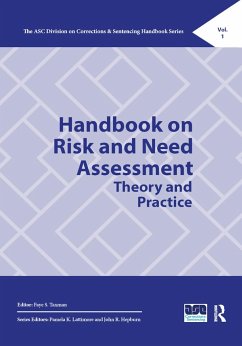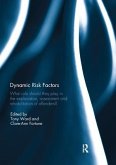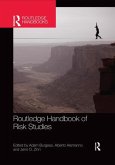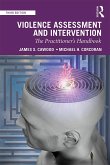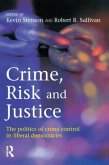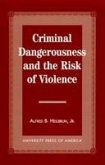Handbook on Risk and Need Assessment
Theory and Practice
Herausgeber: Taxman, Faye S.
Handbook on Risk and Need Assessment
Theory and Practice
Herausgeber: Taxman, Faye S.
- Broschiertes Buch
- Merkliste
- Auf die Merkliste
- Bewerten Bewerten
- Teilen
- Produkt teilen
- Produkterinnerung
- Produkterinnerung
The Handbook on Risk and Need Assessment: Theory and Practice covers risk assessments for individuals being considered for parole or probation. Evidence-based approaches to such decisions help take the emotion and politics out of community corrections. As the United States begins to back away from ineffective, expensive policies of mass incarceration, this handbook will provide the resources needed to help ensure both public safety and the effective rehabilitation of offenders. The ASC Division on Corrections & Sentencing Handbook Series will publish volumes on topics ranging from violence…mehr
Andere Kunden interessierten sich auch für
![Dangerousness, Risk and the Governance of Serious Sexual and Violent Offenders Dangerousness, Risk and the Governance of Serious Sexual and Violent Offenders]() Karen HarrisonDangerousness, Risk and the Governance of Serious Sexual and Violent Offenders73,99 €
Karen HarrisonDangerousness, Risk and the Governance of Serious Sexual and Violent Offenders73,99 €![Dynamic Risk Factors Dynamic Risk Factors]() Dynamic Risk Factors65,99 €
Dynamic Risk Factors65,99 €![Routledge Handbook of Risk Studies Routledge Handbook of Risk Studies]() Routledge Handbook of Risk Studies68,99 €
Routledge Handbook of Risk Studies68,99 €![Violence Assessment and Intervention Violence Assessment and Intervention]() James S. CawoodViolence Assessment and Intervention105,99 €
James S. CawoodViolence Assessment and Intervention105,99 €![Crime, Risk and Insecurity Crime, Risk and Insecurity]() Tim HopeCrime, Risk and Insecurity73,99 €
Tim HopeCrime, Risk and Insecurity73,99 €![Crime, Risk and Justice Crime, Risk and Justice]() Crime, Risk and Justice60,99 €
Crime, Risk and Justice60,99 €![Criminal Dangerousness and the Risk of Violence Criminal Dangerousness and the Risk of Violence]() Alfred B HeilbrunCriminal Dangerousness and the Risk of Violence78,99 €
Alfred B HeilbrunCriminal Dangerousness and the Risk of Violence78,99 €-
-
-
The Handbook on Risk and Need Assessment: Theory and Practice covers risk assessments for individuals being considered for parole or probation. Evidence-based approaches to such decisions help take the emotion and politics out of community corrections. As the United States begins to back away from ineffective, expensive policies of mass incarceration, this handbook will provide the resources needed to help ensure both public safety and the effective rehabilitation of offenders. The ASC Division on Corrections & Sentencing Handbook Series will publish volumes on topics ranging from violence risk assessment to specialty courts for drug users, veterans, or the mentally ill. Each thematic volume focuses on a single topical issue that intersects with corrections and sentencing research.
Hinweis: Dieser Artikel kann nur an eine deutsche Lieferadresse ausgeliefert werden.
Hinweis: Dieser Artikel kann nur an eine deutsche Lieferadresse ausgeliefert werden.
Produktdetails
- Produktdetails
- Verlag: Routledge
- Seitenzahl: 494
- Erscheinungstermin: 2. Oktober 2019
- Englisch
- Abmessung: 254mm x 178mm x 26mm
- Gewicht: 920g
- ISBN-13: 9780367405175
- ISBN-10: 0367405172
- Artikelnr.: 58053152
- Verlag: Routledge
- Seitenzahl: 494
- Erscheinungstermin: 2. Oktober 2019
- Englisch
- Abmessung: 254mm x 178mm x 26mm
- Gewicht: 920g
- ISBN-13: 9780367405175
- ISBN-10: 0367405172
- Artikelnr.: 58053152
Faye S. Taxman, PhD, is a University Professor in the Criminology, Society, and Law program at George Mason University in Fairfax, VA, and director of its Center for Advancing Corrections Excellence. A well-regarded scholar and researcher, she is Past Chair of the American Society of Criminology's Division on Corrections & Sentencing.
1. The Value and Importance of Risk and Need Assessment in Corrections &
Sentencing: An Overview of the Handbook
Faye S. Taxman, George Mason University
Amy Dezember, George Mason University
History of RNA
2. Risk and Needs Assessment in Probation and Parole: The Persistent Gap
Between Promise and Practice
William D. Burrell
3. The Research Director Perspective on the Design, Implementation, and
Impact of Risk Assessment and Offender Classification Systems in USA
Prisons: A National Survey
James Byrne, University of Massachusetts, Lowell
Amy Dezember, George Mason University
Methodological Issues in Creating and Validating RNA
4. Static Risk Factors and Criminal Recidivism
Robert Brame, University of South Carolina
5. Accuracy of Risk Assessment in Corrections Population Management:
Where's the Value Added?
James Hess, University of California, Irvine
Susan Turner, University of California, Irvine
6. Improving the Performance of Risk Assessments: A Case Study on the
Prediction of Sexual Offending among Juvenile Offenders
KiDeuk Kim, The Urban Institute
Grant Duwe, Minnesota Department of Corrections
7. Using Predictive Analytics and Machine Learning to Improve the
Accuracy and Performance of Juvenile Justice Risk Assessment
Instruments: The Florida Case Study
Ira M. Schwartz, Consultant and Advisor to Algorhythm
Peter York, Founder and CEO of Algorhythm
Mark Greenwald, Director of Research, Florida Department of Juvenile
Justice and Doctoral Student at Florida State University
Ana Ramos-Hernandez, Data Manager, Algorhythm
Lisa Feeley, Research Analyst, ICF International
8. An Alternative Scientific Paradigm for Criminological Risk
Assessment: Closed or Open Systems, or Both?
Tim Brennan, Northpointe, Inc.
Dynamic Risk Factors and Responsivity Toward Different Populations
9. Risk, Need, and Responsivity in a Criminal Lifestyle
Glenn D. Walters, Kutztown University
10. Gender-Responsive Risk and Need Assessment: Implications for the
Treatment of Justice-Involved Women
Emily J. Salisbury, University of Nevada, Las Vegas
Breanna Boppre, University of Nevada, Las Vegas
Bridget Kelly, University of Nevada, Las Vegas
11. Advancing Sexual Offender Risk Assessment: Standardized Risk Levels
Based on Psychologically Meaningful Offender Characteristics
R. Karl Hanson, Public Safety Canada
Guy Bourgon, Public Safety Canada
12. Incorporating Procedural Justice and Legitimacy into the RNR Model to
Improve Risk-Need Assessment
Katherine Ginsburg-Kempany, Arizona State University
Kimberly A. Kaiser, Arizona State University
13. Adoption of Risk Tools to Employment Context
Garima Siwach, University at Albany (SUNY)
Shawn D. Bushway, University at Albany (SUNY)
14. Exploring How to Measure Criminogenic Needs: Five Instruments and No
Real Answers
Brittney Via, George Mason University
Amy Dezember, George Mason University
Faye Taxman, George Mason University
RNA Implementation and Practice
15. Customizing Criminal Justice Assessments
Zachary Hamilton, Washington State University
Elizabeth Thompson Tollefsbol, Washington State University
Michael Campagna, Washington State University
Jacqueline van Wormer, Washington State University
16. Risk/Need Assessment Tools and the Criminal Justice Bureaucrat:
Reconceptualizing the Frontline Practitioner
Joel Miller, Rutgers University
Sarah Trocchio, Rutgers University
17. Risky Needs: Risk Entangled Needs in Probation Supervision
Danielle S. Rudes, George Mason University
Jill Viglione, University of Texas, San Antonio
Kimberly S. Meyer, George Mason University
Special Issues Regarding the Conceptualization for RNA
18. Purpose and Context Matters: Creating a Space for Meaningful
Dialogues about Risk and Need
Kelly Hannah-Moffat, Director Centre for Criminology & Sociolegal
Studies, University of Toronto, Canadiana Gallery
19. Human Rights and High Risk Offenders: The Right to Rehabilitation and
the Right to Fairness
Mary Rogan, Barrister-at-Law, Head of Law and Assistant Head of the
School of Languages, Law and Social Sciences, Dublin Institute of
Technology
Sentencing: An Overview of the Handbook
Faye S. Taxman, George Mason University
Amy Dezember, George Mason University
History of RNA
2. Risk and Needs Assessment in Probation and Parole: The Persistent Gap
Between Promise and Practice
William D. Burrell
3. The Research Director Perspective on the Design, Implementation, and
Impact of Risk Assessment and Offender Classification Systems in USA
Prisons: A National Survey
James Byrne, University of Massachusetts, Lowell
Amy Dezember, George Mason University
Methodological Issues in Creating and Validating RNA
4. Static Risk Factors and Criminal Recidivism
Robert Brame, University of South Carolina
5. Accuracy of Risk Assessment in Corrections Population Management:
Where's the Value Added?
James Hess, University of California, Irvine
Susan Turner, University of California, Irvine
6. Improving the Performance of Risk Assessments: A Case Study on the
Prediction of Sexual Offending among Juvenile Offenders
KiDeuk Kim, The Urban Institute
Grant Duwe, Minnesota Department of Corrections
7. Using Predictive Analytics and Machine Learning to Improve the
Accuracy and Performance of Juvenile Justice Risk Assessment
Instruments: The Florida Case Study
Ira M. Schwartz, Consultant and Advisor to Algorhythm
Peter York, Founder and CEO of Algorhythm
Mark Greenwald, Director of Research, Florida Department of Juvenile
Justice and Doctoral Student at Florida State University
Ana Ramos-Hernandez, Data Manager, Algorhythm
Lisa Feeley, Research Analyst, ICF International
8. An Alternative Scientific Paradigm for Criminological Risk
Assessment: Closed or Open Systems, or Both?
Tim Brennan, Northpointe, Inc.
Dynamic Risk Factors and Responsivity Toward Different Populations
9. Risk, Need, and Responsivity in a Criminal Lifestyle
Glenn D. Walters, Kutztown University
10. Gender-Responsive Risk and Need Assessment: Implications for the
Treatment of Justice-Involved Women
Emily J. Salisbury, University of Nevada, Las Vegas
Breanna Boppre, University of Nevada, Las Vegas
Bridget Kelly, University of Nevada, Las Vegas
11. Advancing Sexual Offender Risk Assessment: Standardized Risk Levels
Based on Psychologically Meaningful Offender Characteristics
R. Karl Hanson, Public Safety Canada
Guy Bourgon, Public Safety Canada
12. Incorporating Procedural Justice and Legitimacy into the RNR Model to
Improve Risk-Need Assessment
Katherine Ginsburg-Kempany, Arizona State University
Kimberly A. Kaiser, Arizona State University
13. Adoption of Risk Tools to Employment Context
Garima Siwach, University at Albany (SUNY)
Shawn D. Bushway, University at Albany (SUNY)
14. Exploring How to Measure Criminogenic Needs: Five Instruments and No
Real Answers
Brittney Via, George Mason University
Amy Dezember, George Mason University
Faye Taxman, George Mason University
RNA Implementation and Practice
15. Customizing Criminal Justice Assessments
Zachary Hamilton, Washington State University
Elizabeth Thompson Tollefsbol, Washington State University
Michael Campagna, Washington State University
Jacqueline van Wormer, Washington State University
16. Risk/Need Assessment Tools and the Criminal Justice Bureaucrat:
Reconceptualizing the Frontline Practitioner
Joel Miller, Rutgers University
Sarah Trocchio, Rutgers University
17. Risky Needs: Risk Entangled Needs in Probation Supervision
Danielle S. Rudes, George Mason University
Jill Viglione, University of Texas, San Antonio
Kimberly S. Meyer, George Mason University
Special Issues Regarding the Conceptualization for RNA
18. Purpose and Context Matters: Creating a Space for Meaningful
Dialogues about Risk and Need
Kelly Hannah-Moffat, Director Centre for Criminology & Sociolegal
Studies, University of Toronto, Canadiana Gallery
19. Human Rights and High Risk Offenders: The Right to Rehabilitation and
the Right to Fairness
Mary Rogan, Barrister-at-Law, Head of Law and Assistant Head of the
School of Languages, Law and Social Sciences, Dublin Institute of
Technology
1. The Value and Importance of Risk and Need Assessment in Corrections &
Sentencing: An Overview of the Handbook
Faye S. Taxman, George Mason University
Amy Dezember, George Mason University
History of RNA
2. Risk and Needs Assessment in Probation and Parole: The Persistent Gap
Between Promise and Practice
William D. Burrell
3. The Research Director Perspective on the Design, Implementation, and
Impact of Risk Assessment and Offender Classification Systems in USA
Prisons: A National Survey
James Byrne, University of Massachusetts, Lowell
Amy Dezember, George Mason University
Methodological Issues in Creating and Validating RNA
4. Static Risk Factors and Criminal Recidivism
Robert Brame, University of South Carolina
5. Accuracy of Risk Assessment in Corrections Population Management:
Where's the Value Added?
James Hess, University of California, Irvine
Susan Turner, University of California, Irvine
6. Improving the Performance of Risk Assessments: A Case Study on the
Prediction of Sexual Offending among Juvenile Offenders
KiDeuk Kim, The Urban Institute
Grant Duwe, Minnesota Department of Corrections
7. Using Predictive Analytics and Machine Learning to Improve the
Accuracy and Performance of Juvenile Justice Risk Assessment
Instruments: The Florida Case Study
Ira M. Schwartz, Consultant and Advisor to Algorhythm
Peter York, Founder and CEO of Algorhythm
Mark Greenwald, Director of Research, Florida Department of Juvenile
Justice and Doctoral Student at Florida State University
Ana Ramos-Hernandez, Data Manager, Algorhythm
Lisa Feeley, Research Analyst, ICF International
8. An Alternative Scientific Paradigm for Criminological Risk
Assessment: Closed or Open Systems, or Both?
Tim Brennan, Northpointe, Inc.
Dynamic Risk Factors and Responsivity Toward Different Populations
9. Risk, Need, and Responsivity in a Criminal Lifestyle
Glenn D. Walters, Kutztown University
10. Gender-Responsive Risk and Need Assessment: Implications for the
Treatment of Justice-Involved Women
Emily J. Salisbury, University of Nevada, Las Vegas
Breanna Boppre, University of Nevada, Las Vegas
Bridget Kelly, University of Nevada, Las Vegas
11. Advancing Sexual Offender Risk Assessment: Standardized Risk Levels
Based on Psychologically Meaningful Offender Characteristics
R. Karl Hanson, Public Safety Canada
Guy Bourgon, Public Safety Canada
12. Incorporating Procedural Justice and Legitimacy into the RNR Model to
Improve Risk-Need Assessment
Katherine Ginsburg-Kempany, Arizona State University
Kimberly A. Kaiser, Arizona State University
13. Adoption of Risk Tools to Employment Context
Garima Siwach, University at Albany (SUNY)
Shawn D. Bushway, University at Albany (SUNY)
14. Exploring How to Measure Criminogenic Needs: Five Instruments and No
Real Answers
Brittney Via, George Mason University
Amy Dezember, George Mason University
Faye Taxman, George Mason University
RNA Implementation and Practice
15. Customizing Criminal Justice Assessments
Zachary Hamilton, Washington State University
Elizabeth Thompson Tollefsbol, Washington State University
Michael Campagna, Washington State University
Jacqueline van Wormer, Washington State University
16. Risk/Need Assessment Tools and the Criminal Justice Bureaucrat:
Reconceptualizing the Frontline Practitioner
Joel Miller, Rutgers University
Sarah Trocchio, Rutgers University
17. Risky Needs: Risk Entangled Needs in Probation Supervision
Danielle S. Rudes, George Mason University
Jill Viglione, University of Texas, San Antonio
Kimberly S. Meyer, George Mason University
Special Issues Regarding the Conceptualization for RNA
18. Purpose and Context Matters: Creating a Space for Meaningful
Dialogues about Risk and Need
Kelly Hannah-Moffat, Director Centre for Criminology & Sociolegal
Studies, University of Toronto, Canadiana Gallery
19. Human Rights and High Risk Offenders: The Right to Rehabilitation and
the Right to Fairness
Mary Rogan, Barrister-at-Law, Head of Law and Assistant Head of the
School of Languages, Law and Social Sciences, Dublin Institute of
Technology
Sentencing: An Overview of the Handbook
Faye S. Taxman, George Mason University
Amy Dezember, George Mason University
History of RNA
2. Risk and Needs Assessment in Probation and Parole: The Persistent Gap
Between Promise and Practice
William D. Burrell
3. The Research Director Perspective on the Design, Implementation, and
Impact of Risk Assessment and Offender Classification Systems in USA
Prisons: A National Survey
James Byrne, University of Massachusetts, Lowell
Amy Dezember, George Mason University
Methodological Issues in Creating and Validating RNA
4. Static Risk Factors and Criminal Recidivism
Robert Brame, University of South Carolina
5. Accuracy of Risk Assessment in Corrections Population Management:
Where's the Value Added?
James Hess, University of California, Irvine
Susan Turner, University of California, Irvine
6. Improving the Performance of Risk Assessments: A Case Study on the
Prediction of Sexual Offending among Juvenile Offenders
KiDeuk Kim, The Urban Institute
Grant Duwe, Minnesota Department of Corrections
7. Using Predictive Analytics and Machine Learning to Improve the
Accuracy and Performance of Juvenile Justice Risk Assessment
Instruments: The Florida Case Study
Ira M. Schwartz, Consultant and Advisor to Algorhythm
Peter York, Founder and CEO of Algorhythm
Mark Greenwald, Director of Research, Florida Department of Juvenile
Justice and Doctoral Student at Florida State University
Ana Ramos-Hernandez, Data Manager, Algorhythm
Lisa Feeley, Research Analyst, ICF International
8. An Alternative Scientific Paradigm for Criminological Risk
Assessment: Closed or Open Systems, or Both?
Tim Brennan, Northpointe, Inc.
Dynamic Risk Factors and Responsivity Toward Different Populations
9. Risk, Need, and Responsivity in a Criminal Lifestyle
Glenn D. Walters, Kutztown University
10. Gender-Responsive Risk and Need Assessment: Implications for the
Treatment of Justice-Involved Women
Emily J. Salisbury, University of Nevada, Las Vegas
Breanna Boppre, University of Nevada, Las Vegas
Bridget Kelly, University of Nevada, Las Vegas
11. Advancing Sexual Offender Risk Assessment: Standardized Risk Levels
Based on Psychologically Meaningful Offender Characteristics
R. Karl Hanson, Public Safety Canada
Guy Bourgon, Public Safety Canada
12. Incorporating Procedural Justice and Legitimacy into the RNR Model to
Improve Risk-Need Assessment
Katherine Ginsburg-Kempany, Arizona State University
Kimberly A. Kaiser, Arizona State University
13. Adoption of Risk Tools to Employment Context
Garima Siwach, University at Albany (SUNY)
Shawn D. Bushway, University at Albany (SUNY)
14. Exploring How to Measure Criminogenic Needs: Five Instruments and No
Real Answers
Brittney Via, George Mason University
Amy Dezember, George Mason University
Faye Taxman, George Mason University
RNA Implementation and Practice
15. Customizing Criminal Justice Assessments
Zachary Hamilton, Washington State University
Elizabeth Thompson Tollefsbol, Washington State University
Michael Campagna, Washington State University
Jacqueline van Wormer, Washington State University
16. Risk/Need Assessment Tools and the Criminal Justice Bureaucrat:
Reconceptualizing the Frontline Practitioner
Joel Miller, Rutgers University
Sarah Trocchio, Rutgers University
17. Risky Needs: Risk Entangled Needs in Probation Supervision
Danielle S. Rudes, George Mason University
Jill Viglione, University of Texas, San Antonio
Kimberly S. Meyer, George Mason University
Special Issues Regarding the Conceptualization for RNA
18. Purpose and Context Matters: Creating a Space for Meaningful
Dialogues about Risk and Need
Kelly Hannah-Moffat, Director Centre for Criminology & Sociolegal
Studies, University of Toronto, Canadiana Gallery
19. Human Rights and High Risk Offenders: The Right to Rehabilitation and
the Right to Fairness
Mary Rogan, Barrister-at-Law, Head of Law and Assistant Head of the
School of Languages, Law and Social Sciences, Dublin Institute of
Technology
